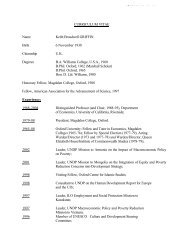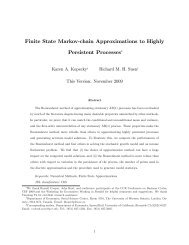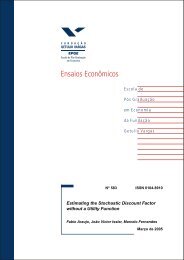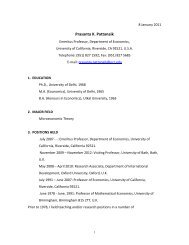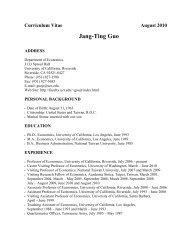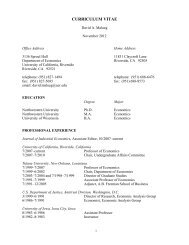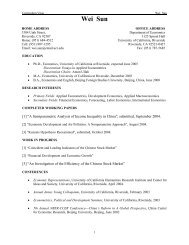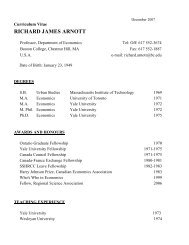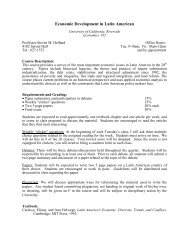Copula-based Multivariate GARCH Model with ... - Economics
Copula-based Multivariate GARCH Model with ... - Economics
Copula-based Multivariate GARCH Model with ... - Economics
You also want an ePaper? Increase the reach of your titles
YUMPU automatically turns print PDFs into web optimized ePapers that Google loves.
models using the three foreign exchange rates. The empirical results from the in-sample and OOS<br />
analysis clearly demonstrate the advantages of the new model.<br />
7 Appendix<br />
We present here some details on copula functions for two widely used copula families — elliptical<br />
copula family and Archimedean copula family. The former includes the Gaussian copula and the<br />
Student’s t copula. The latter includes Gumbel copula, Clayton copula and Frank copula. We also<br />
discuss the survival copulas of Archimedean copulas and m-variate Archimedean copulas.<br />
7.1 Elliptical copulas<br />
Gaussian copula: Let R be the symmetric, positive definite correlation matrix and Φ R (·, ·) be<br />
the standard bivariate normal distribution <strong>with</strong> correlation matrix R.<br />
bivariate Gaussian copula is:<br />
The density function of<br />
c Gaussian (u 1 ,u 2 )= 1<br />
|R| 1/2 exp(−1 2 η0 (R −1 −I)η), (25)<br />
where η =(Φ −1 (u 1 ) Φ −1 (u 2 )) 0 and Φ −1 (·) is the inverse of the univariate normal CDF. The bivariate<br />
Gaussian copula is:<br />
C Gaussian (u 1 ,u 2 ; R) =Φ R<br />
¡<br />
Φ −1 (u 1 ), Φ −1 (u 2 ) ¢ .<br />
Hu (2003) shows the bivariate Gaussian copula can be approximated by Taylor expansion:<br />
C Gaussian (u 1 ,u 2 ; θ) ≈ u 1 u 2 + θ · φ(Φ −1 (u 1 ))φ(Φ −1 (u 2 )),<br />
where φ is the density function of univariate Gaussian distribution and θ is the correlation coefficient<br />
between η 1 and η 2 . Both the upper tail dependence λ U and the lower tail dependence λ L are zero,<br />
reflecting the asymptotic tail independence of Gaussian copula.<br />
Student’s t copula: Letω c be the degree of freedom, and T R,ωc (·, ·) be the standard bivariate<br />
Student’s t distribution <strong>with</strong> degree of freedom ω c and correlation matrix R. The density function<br />
of bivariate Student’s t copula is:<br />
c Student’s t (u 1 ,u 2 ; R,ω c )=|R| − 1 Γ( ω c+2<br />
2<br />
2<br />
)Γ( ω c<br />
2<br />
) (1 + η0 R −1 η<br />
Γ( ωc+1<br />
2<br />
) 2 Π 2 i=1 (1 + η2 i<br />
ω c<br />
) − ω c+2<br />
2<br />
ω c<br />
) − ω c+1<br />
2<br />
where η =(t −1<br />
ω c<br />
(u 1 ),t −1<br />
ω c<br />
(u 2 )) 0 ,u 1 = t ω1 (x), u 2 = t ω2 (y), and t ωi (·) is the univariate Student’s t<br />
CDF <strong>with</strong> degree of freedom ω i . The bivariate Student’s t copula is<br />
C Student’s t (u 1 ,u 2 ; R,ω c )=T R,ωc<br />
¡<br />
t<br />
−1<br />
ω c<br />
(u 1 ),t −1<br />
ω c<br />
(u 2 ) ¢ .<br />
20




